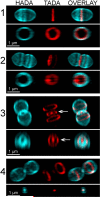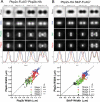Pbp2x localizes separately from Pbp2b and other peptidoglycan synthesis proteins during later stages of cell division of Streptococcus pneumoniae D39
- PMID: 25099088
- PMCID: PMC4209751
- DOI: 10.1111/mmi.12745
Pbp2x localizes separately from Pbp2b and other peptidoglycan synthesis proteins during later stages of cell division of Streptococcus pneumoniae D39
Abstract
The relative localization patterns of class B penicillin-binding proteins Pbp2x and Pbp2b were used as positional indicators of septal and peripheral (side-wall-like) peptidoglycan (PG) synthesis, respectively, in the mid-cell regions of Streptococcus pneumoniae cells at different stages of division. We confirm that Pbp2x and Pbp2b are essential in the strain D39 genetic background, which differs from that of laboratory strains. We show that Pbp2b, like Pbp2x and class A Pbp1a, follows a different localization pattern than FtsZ and remains at division septa after FtsZ reappears at the equators of daughter cells. Pulse-experiments with fluorescent D-amino acids (FDAAs) were performed in wild-type cells and in cells in which Pbp2x activity was preferentially inhibited by methicillin or Pbp2x amount was depleted. These experiments show that Pbp2x activity separates from that of other PBPs to the centres of constricting septa in mid-to-late divisional cells resolved by high-resolution 3D-SIM microscopy. Dual-protein and protein-fluorescent vancomycin 2D and 3D-SIM immunofluorescence microscopy (IFM) of cells at different division stages corroborate that Pbp2x separates to the centres of septa surrounded by an adjacent constricting ring containing Pbp2b, Pbp1a and regulators, StkP and MreC. The separate localization of Pbp2x suggests distinctive roles in completing septal PG synthesis and remodelling.
© 2014 John Wiley & Sons Ltd.
Figures












Comment in
-
Molecular surveillance of the subtle septum: discovering a new mode of peptidoglycan synthesis in streptococci.Mol Microbiol. 2014 Oct;94(1):1-4. doi: 10.1111/mmi.12756. Epub 2014 Aug 28. Mol Microbiol. 2014. PMID: 25135390
References
-
- Bartual SG, Straume D, Stamsas GA, Munoz IG, Alfonso C, Martinez-Ripoll M, Havarstein LS, Hermoso JA. Structural basis of PcsB-mediated cell separation in Streptococcus pneumoniae. Nature commun. 2014;5:3842. - PubMed
Publication types
MeSH terms
Substances
Grants and funding
LinkOut - more resources
Full Text Sources
Other Literature Sources

